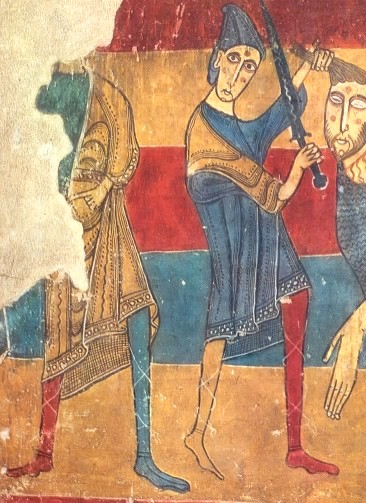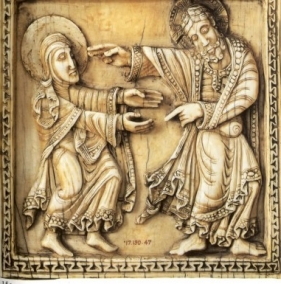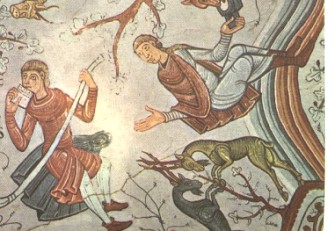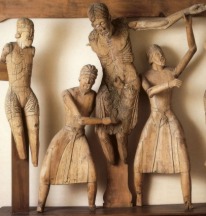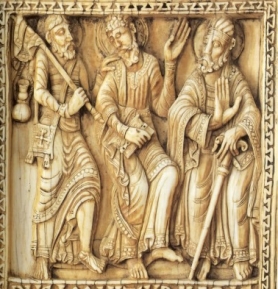|
| |
Left: The Miraculous Fishing- Parish church
at Sorpe (Lérida) Museum of Catalan Art, Barcelona
Right: David and Goliath. Cataluña, c. 1123. obra
del maestro del Juicio Final (Lérida) Museum of Catalan Art, Barcelona |
|
| |
Left: Noli Me Tangere. Ivory plaque from a reliquary, Léon,
ca.1115-20. The Metropolitan Museum of Art, NY
Right: Annunciation of the Shepherds-portico of San Isidoro
at León |
|
| The main garments for men and women were
the brial, worn under the piel/pellizón,
and a cloak. (The words almexia and tunica continued
to be used.) The brial was a tunic, usually with tight sleeves;
women wore the long brial, but men favored a somewhat shorter
version which could also be split to facilitate riding. The brial
was usually made of rich fabric such as cenda (thin silk), xamet,
or ciclatón (silk made with gold). Cuffs were usually
decorated with geometric or spiral patterns, but we are not sure how these
were applied, and small, over-all fabric designs are still evident. |
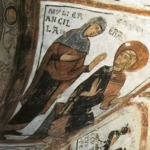
Panteón de los reyes en San Isidoro de Léon |
|
 |
| The piel or pellizón
was worn over the brial and, like the brial, could have
a split skirt. Sleeves, however, were shorter and wider (even knotted)
and feminine versions show tight sleeves that widen abruptly at the wrist.
The name pellizón comes from the fur lining that was hidden
by another fabric lining; favorite furs were ermine, abortones,
rabbit, and lamb. These garments were decorated with bands around the
low neckline, the edges of the sleeves, the hems of the skirts, and across
the upper sleeves (also a Muslim style). |
| |
Left: Erill la Vall (Lleida) mid(?) –12th Century.
Museu Arqueologic-Artistic Episcopal, Vic
Right: The Journey to Emmaus. Ivory plaque from a reliquary,
Léon, ca.1115-20. The Metropolitan museuem of Art, NY
|
|
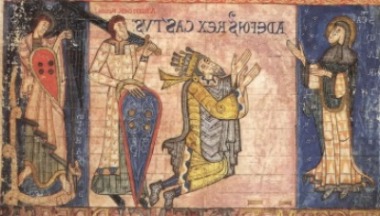
Monastery of Santos Facumdo y Primitivo,
Sahagún (?) (León), ca. 1118 |
Bernis says that cloaks were worn indoors and out and
that the old Roman pallium and semi-circular cloaks continued to be used.
Also very popular at this time was a cape with only an opening for the
head, topped by a hood; women preferred a shorter version of the cloak,
similar to a modern-day poncho. |
| Tubrucos (pants) continued to be worn but
were being relegated to the lower classes. A new king of leg/footwear
became favored that was fitted to the leg and probably fastened to bracae. |
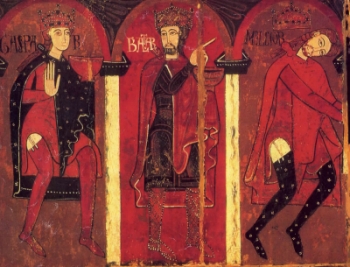
The Three Kings. Altar fontal of Espinelves, Museu Episcopal, Vic,
ca. 1200
|
During this period men rarely covered their
hair, which could be long or short, and worn in braids. Underneath the
cappillo de armor (helm), however, a coffia gathered
the hair, and the cappillo of iron, which was conical, gave its
name to a pointed cloth headpiece.
|
Beards were common and symbolic; an unkempt beard, or
one braided with a cloth cord was a sign of mourning, while holding one's
beard in the hand showed great satisfaction or arrogance. A supreme insult
was to stroke another man's beard; El Cid swore an oath por aquesta barba
que nadi non mess-, meaning "by this beard that no man touches." |
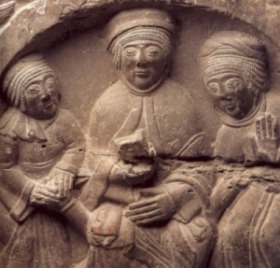
Sarcophagus of Doña Sancha,
Convent of Santa Cruz de la Serós (Huesca)
First quarter of 12th Century
|
Women, on the other hand, always wore a head covering
of some kind. One style, showing Byzantine influence, covered the head,
neck, shoulders, and sometimes the chest, while another style shows layers
of crimped cloth wound around the face and neck. To both of these styles
could be added a hat. |
12th Century Gallery
Home |


